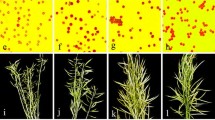Abstract
Synthetic hybrids is one of the ways to heterosis application in rapeseed, which can effectively solve the problems of the promotion of extra-early-maturing rapeseed varieties in high altitude areas. The flowering period, the yield and the outcrossing rate of the restorer lines, and the yield of their F1s crossed with the sterile line are crucial factors for breeding synthetic hybrids. In this study, one excellent extra-early-maturing Brassica napus sterile line and 28 restorer lines were used as plant materials. Three excellent restorer lines (2036, 137, and 52) were selected by investigating the flowering period, the genetic differences and the yield of each restorer line, and the yield of their hybrid F1 crossed with the sterile line. DNA fingerprinting was performed with SSR molecular markers. The three restorer lines had outcrossing rates from high to low as follows: 137 (59.00%) > 2036 (46.90%) > 52 (30.55%). In addition, the pollen tube germination of each restorer line was observed, and their hybridization and self-compatibility were explored to explain the rates of outcrossing. Collectively, our results suggest that the proportion of the three restorer lines was 137 > 2036 > 52 when using these three extra-early-maturing and sterile rapeseed lines to prepare synthetic hybrids.





Similar content being viewed by others
References
Creste S, Neto AT, Figueira A (2001) Detection of single sequence repeat polymorphisms in denaturing polyacrylamide sequencing gels by silver staining. Plant Mol Biol Rep 19:299–306. https://doi.org/10.1007/BF02772828
Dey SS, Singh N, Bhatia R, Parkash C, Chandel CE (2014) Genetic combining ability and heterosis for important vitamins and antioxidant pigments in cauliflower (Brassica oleracea var. botrytis L.). Euphytica 195:169–181. https://doi.org/10.1007/s10681-013-0981-4
Doyle J, Doyle JL (1990) Isolation of plant DNA from fresh tissue. Focus 12:13–15
José M, Iban E, Silvia A, Pere A (2005) Inheritance mode of fruit traits in melon: heterosis for fruit shape and its correlation with genetic distance. Euphytica 144:31–38. https://doi.org/10.1007/s10681-005-0201-y
Rajendran N, Mukherjee L, Reddy KK, Shashidhar HE (2012) DNA fingerprinting and estimation of genetic diversity among hybrid rice parental lines (Oryza sativa L.) using simple sequence repeats (SSR) markers. J Plant Breed Crop Sci 4:169–174. https://doi.org/10.5897/JPBCS12.008
Singh S, Dey SS, Bhatia R, Kumar R, Behera TK (2019) Heterosis and combining ability in cytoplasmic male sterile and doubled haploid based Brassica oleracea progenies and prediction of heterosis using microsatellites. PLoS ONE 14:e0210772. https://doi.org/10.1371/journal.pone.0210772
Tian HY, Channa SA, Hu SW (2017) Relationships between genetic distance, combining ability and heterosis in rapeseed (Brassica napus L.). Euphytica. https://doi.org/10.1007/s10681-016-1788-x
Ting-dong F (2000) Breeding and utilization of rapeseed hybrid. Hubei Science and Technology Press, Hu Bei
Yang M, Huang C, Wang M, Fan H, Guan R (2019) Fine mapping of an up-curling leaf locus (BnUC1) in Brassica napus. BMC Plant Biol. https://doi.org/10.1186/s12870-019-1938-0
Yu CY, Hu SW, Zhao HX, Guo AG, Sun GL (2005) Genetic distances revealed by morphological characters, isozymes, proteins and RAPD markers and their relationships with hybrid performance in oilseed rape (Brassica napus L.). Theor Appl Genet 110:511–518. https://doi.org/10.1007/s00122-004-1858-7
Yu HL, Li ZY, Ren WJ, Han FQ, Yang LM, Zhuang M, Lv HH, Liu YM, Fang ZY, Zhang YY (2020) Creation of fertility-restored materials for Ogura CMS in Brassica oleracea by introducing Rfo gene from Brassica napus via an allotriploid strategy. Theor Appl Genet 133:2825–2837. https://doi.org/10.1007/s00122-020-03635-8
Zhang J, Li G, Li H, Pu X, Jiang J, Chai L, Zheng B, Cheng C, Yang Z, Zhu Y (2015) Transcriptome analysis of interspecific hybrid between Brassica napus and B. rapa reveals heterosis for oil rape improvement. Int J Genom 2015:230985. https://doi.org/10.1155/2015/230985
Funding
This research was supported by the Earmarked Fund for China Agriculture Research System (CRAS-12), the Qinghai Natural Science Foundation Program-innovation team (2022-ZJ-902), and the Qinghai Innovation Platform Construction Project (2022-ZJ-Y01; 2022-ZJ-Y13).
Author information
Authors and Affiliations
Contributions
DD conceived and designed the study. LZ and KL performed the experiments, analyzed the data and wrote the manuscript. LZ, KL and YJ modified the article. All authors read and approved the manuscript.
Corresponding author
Ethics declarations
Conflict of interest
We do not have any commercial or associative conflicts of interest regarding the research in this paper.
Ethical approval
This article does not describe any studies involving human participants or animals.
Additional information
Publisher's Note
Springer Nature remains neutral with regard to jurisdictional claims in published maps and institutional affiliations.
Supplementary Information
Below is the link to the electronic supplementary material.
Rights and permissions
Springer Nature or its licensor (e.g. a society or other partner) holds exclusive rights to this article under a publishing agreement with the author(s) or other rightsholder(s); author self-archiving of the accepted manuscript version of this article is solely governed by the terms of such publishing agreement and applicable law.
About this article
Cite this article
Zan, L., Li, K., Jia, Y. et al. Screening and evaluation of three restorer lines used to create synthetic hybrids of extra-early-maturing Brassica napus. Euphytica 219, 45 (2023). https://doi.org/10.1007/s10681-023-03175-4
Received:
Accepted:
Published:
DOI: https://doi.org/10.1007/s10681-023-03175-4




